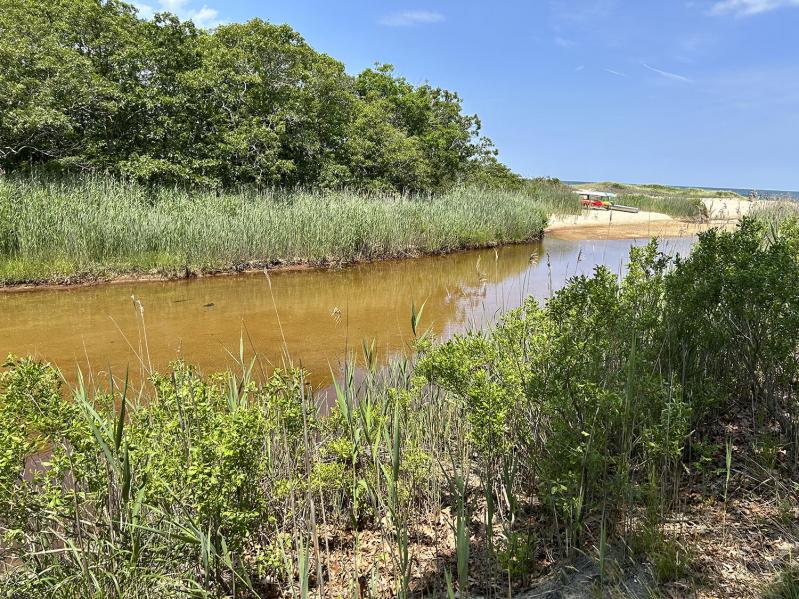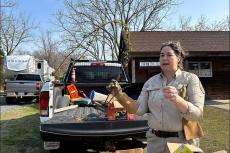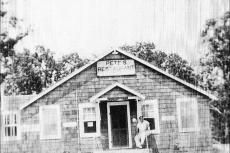Even on a cloudy, gray Tuesday afternoon there are plenty of people at Fresh Pond in Amagansett. Kids wade into the waters and walk along the sand by the creek, paddleboarders splash around through the small waves, and some walk along the jetty pausing to admire the view or even to fish off the rocks. It is a classic and popular beach spot for many in the summer, especially families with young children, but how much is going on below the surface?
Fresh Pond is one of 31 sites regularly tested and monitored for enterococcus bacteria by Concerned Citizens of Montauk in collaboration with the Surfrider Foundation’s Eastern Long Island Chapter. In addition to Fresh Pond, the groups monitor the water quality at 19 sites in Montauk, four in Springs, four in Amagansett, and four in East Hampton. The beaches that Surfrider and C.C.O.M. cover are tested year round, weekly in the summer, and the results are posted on each of their respective websites and the C.C.O.M. Instagram page. In the off-season they are tested biweekly or monthly.
Instead of testing for multiple risk factors in every sample, the county and C.C.O.M. and Surfrider use the federal Environmental Protection Agency-recommended marker of enterococcus bacteria.
Mara Dias is the water quality initiative senior manager for the Surfrider Foundation and overseer of the organization’s Blue Water Task Force, which monitors water quality nationwide in addition to sites in Canada, Puerto Rico, and Costa Rica. She explained why this specific bacterium is tested for and the significance of it.
“It is a fecal-indicator bacteria,” Ms. Dias said. “It’s used by health departments around the country, like Suffolk Health Services, as a predictor of human health risk from recreation and bathing waters.” Ms. Dias noted that it is “not the bacteria itself that gets people sick, but what else could be in there.” If the testing results show a high level of enterococcus bacteria, there’s a good chance that there is fecal pollution, human or animal, in the water, and it’s that that could be harmful to humans and pets.
C.C.O.M. and Surfrider focus on spots that are not tested by the Suffolk County Department of Health and choose the test sites based on how heavily they are used for recreational purposes. The County Health Department tests only “public bathing beaches,” generally understood to be beaches that are lifeguarded and have bathrooms, from May through September.
Among the other spots monitored by C.C.O.M. and Surfrider are three on Accabonac Harbor in Springs, three on Three Mile Harbor, two at Northwest Creek in East Hampton, and two at Napeague Harbor. In Montauk, they monitor nine spots on Lake Montauk, three on the ocean, two on Fort Pond, two on Fort Pond Bay, and two on the Sound.
The groups have teamed up on the water testing for 11 years and have built a fully volunteer network. “This is a large area to cover,” Kay Tyler, the executive director of C.C.O.M., said, “We’re surrounded by water and it takes a lot of hands.”
Surfrider also partners with Peconic Baykeeper to test waters farther west.
Test results can vary widely from week to week.
The E.P.A. considers recreational waters unsafe if the enterococcus bacteria levels exceed 104 colony forming units for marine water bodies and 61 C.F.U. for freshwater bodies.
Back to Fresh Pond, results from testing water at the creek and beachside there fluctuated from low to medium to high in June alone. In results published earlier this week, the bacteria level at Fresh Pond Beach was high, while that in the creek was low.
“The number-one reason we see spikes in our bacteria readings,” Ms. Dias said, “is when we go out and sample after a heavy rain event.”
Heavy rain is not the only cause for spikes in data, sometimes the samples themselves are not totally representative of the whole body of water. “The other thing that happens is enterococcus bacteria when they are in the water don’t disperse evenly; they clump together.” Ms. Dias said, “you can collect two samples and it’s possible you may not get the same result.” Surfrider recently released its annual report for 2023, and that puts all of the weekly testing results into a broader context. Although results within the two Fresh Pond areas that are tested show the occasional spike, they had high bacterial levels only 13 to 18 percent of the time. Not the lowest number on the report, but it is 70 percent lower than the highest result.
This week, the highest bacteria levels were at East Creek and West Creek on Lake Montauk, the Benson Drive culvert on the lake, the Surfide Place outfall pipe on the ocean just east of the downtown area, and Tuthill Pond, a landlocked pond near Duryea’s. Levels were also considered high at the harbor side of Lake Montauk, South Beach on Lake Montauk, the Stepping Stones area of the lake, and at both sites tested on Fort Pond. High bacteria levels were also detected at the head of the harbor on Three Mile Harbor and the Northwest Creek culvert.
C.C.O.M. acts as the designated lab for East Hampton, and it is also working on projects including a floating wetlands effort in Fort Pond, to actually improve water quality.
“We can’t prevent things yet,” Ms. Tyler said, “but we can report and let people know.” Water testing results are posted weekly at preservemontauk.org.




